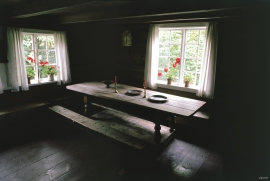Published: 15.01.2013 | Author: Nils Georg Brekke, Tore Lande Moe
The main building on the tax collector’s farm at Huglo is like a well built farmer’s dwelling.
The tax collector’s farm at Sørhuglo is one of the many farms for state employees in Hordaland. According to history, “Futastovo” was built by the tax collector Gram in the second half of the 17th century. In 1943 the building was moved to Sunnhordland Folk Museum.
Ivar Knudsen Gram was tax collector in Sunnhordland in 1648 – 1657. He died in 1697. His family hailed from south Jutland, and at the time several representatives came to Norway as state employees or merchants. Ivar Knudsen was a well-off gentleman and owned several farms. He himself lived most of his life at Sørhuglo, which has ended up being called “Futagarden”. The tax collector’s son and grandson were both country policemen in Føyno coastal administration district.
The original part of the house has two living rooms with a loft above, hallway and a kitchen with an outside passageway.
“Futastova” is probably one of the first loft buildings in Stord. The size corresponds to what we know about housing for state employees and lesser nobility in the 1600s.
Up until 1800 the house was extended. The new part has living room, sitting room, kitchen and porch. An arch above the loft may have been added later still.
A smoke house, probably from the Middle Ages is supposedly an older dwelling at the tax collector’s farm. This has also now been moved to Sunnhordland Folk Museum.
- Espeland, A. (1918) Kalkbrenningi i Sunnhordland. I: Sunnhordland Årbok. Stord, Sunnhordland museum, s. 25-32.
- Sunnhordlandstunet: vegvisar (1961). I: Sunnhordlands-arv, bd. 1. Bergen, Sunnhordland folkemuseum og sogelag.




